What Does Atopic Dermatitis Look Like?
Reviewed by: HU Medical Review Board | Last reviewed: April 2024 | Last updated: August 2025
Atopic dermatitis, also known as eczema, is a common skin condition that affects millions of people worldwide. Characterized by red, inflamed, and itchy patches of skin, eczema can appear differently on different skin tones.1,2
Eczema is harder to spot on people with darker skin. Because eczema can be less visible on darker skin, it may go unnoticed or misdiagnosed, which can delay treatment. Understanding what eczema looks like is crucial for timely diagnosis and effective management.2
Visual signs and symptoms of eczema
Common visual signs and symptoms of eczema include:1-3
- Redness
- Dryness
- Rash
- Blisters
- Thickened skin
- Cracking
- Discoloration
- Skin infection
Redness
One of the most common signs of eczema is red patches on the skin that are dry, scaly, and inflamed. These patches can be small or large and may vary in shape on the body.1
Affected areas commonly include the face, neck, and areas of the body that bend, like the elbow creases and behind the knees. The skin feels rough and may develop tiny bumps or blisters, which can ooze when scratched. Persistent itching worsens the condition and can lead to further skin irritation or skin infections.1
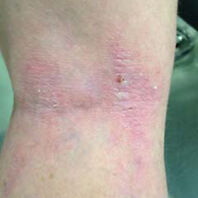
- What redness looks like on fair skin – For those with fair skin, eczema often appears as pink or red patches that are dry, scaly, and inflamed.1,3,4
- What redness looks like on darker skin – For those with darker skin, eczema patches may appear darker brown, ashy gray, or purple.2-4
Dryness
Persistent dryness and itching are hallmark symptoms of eczema. The skin may feel rough and tight. This leads to discomfort and the urge to scratch. Commonly affected areas include places that are prone to eczema flare-ups, such as the face, elbows, and knees.1
- What dryness looks like on fair skin – Dryness on fair skin appears as flakiness or rough patches. The skin may look red, inflamed, tight, and parched. Dry areas may appear lighter in color compared to the surrounding normal skin and be more noticeable.1,3
- What dryness looks like on darker skin – Dryness on darker skin may appear dull or ashy. The skin may lose its natural luster and feel rough to the touch. Dryness can be more challenging to detect on darker skin tones.2-4

Rash
An eczema rash typically consists of raised bumps and/or rough patches on the skin. These can look like goosebumps. These patches vary in size and shape and can cover various areas of the face and body. Dryness, itchiness, and skin texture changes all can accompany a rash.1,2
- What rash looks like on fair skin – A rash on fair skin typically looks like redness and varies in intensity depending on how severe the rash is. The skin may look bumpy or uneven.1,2
- What rash looks like on darker skin – A rash on darker skin may appear as areas of discoloration, which can vary from shades of red, purple, brown, or gray. In some cases, it can make the skin look lighter than the surrounding normal skin tone. Since a rash can make skin dry, it can make areas of darker skin appear ashy or dull. As with fair skin, the skin may look and feel bumpy or uneven.2
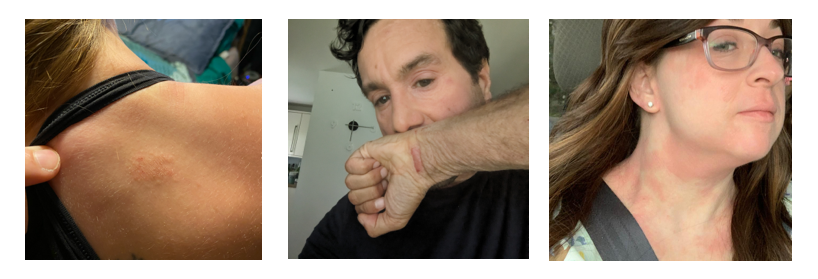
Blisters
In some cases, eczema can lead to the formation of small fluid-filled blisters, also known as vesicles. These blisters are often tender to the touch and may ooze and crust over.1,2
- What blisters look like on fair skin – Blisters can appear as raised, dome-shaped bumps filled with clear fluid. They can be red and inflamed. The redness can also extend beyond the blistered area.1,3,4
- What blisters look like on darker skin – Blisters can appear as raised, dome-shaped bumps, but instead of clear fluid, the fluid within the blisters may appear cloudy. Surrounding the blisters, the skin may appear darker or lighter. This discoloration around the blisters may be more prominent in people with darker skin.2-4
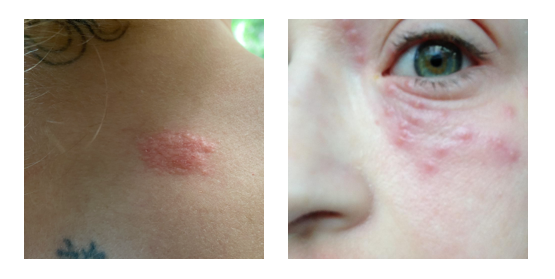
Thickened skin
Chronic scratching and inflammation can cause the skin to thicken and develop a leathery texture. This is called lichenification, It is more common in long-standing or severe cases of eczema. Discoloration can also occur, making a person’s skin look lighter or darker, depending on the person’s normal skin color. As thickened skin heals, the affected area may appear darker than the surrounding skin tone.1-3
- What lichenification looks like on fair skin – Thickened skin appears rough and leathery to the touch. The affected areas may feel hardened and less pliable compared to surrounding areas of the skin. There is an increase in skin lines and wrinkles, which can appear deeper and more pronounced on thickened skin.1,3
- What lichenification looks like on darker skin – On darker skin, thickened skin appears rough and hardened with deeper skin lines or wrinkles. However, these skin changes may be less noticeable compared to fair skin, due to the skin’s deeper pigmentation.2-4
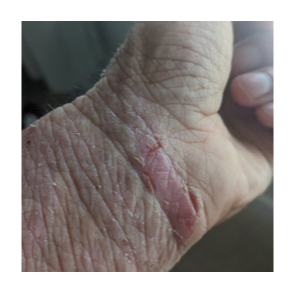
Discoloration
Eczema patches can change the color of a person’s skin. It may appear darker or lighter than the surrounding skin due to changes in pigmentation. This discoloration can persist even after flare-ups have resolved. Sometimes, discoloration may be permanent.1-3
- What discoloration looks like on fair skin – Skin discoloration typically appears red or pink for those with fair skin. It may appear lighter or darker than the surrounding skin, depending on the person’s skin tone.1,3
- What discoloration looks like on darker skin – Skin discoloration may appear as variations in skin color – ranging from shades of brown to gray or purple. It is possible for skin to appear darker or lighter than surrounding skin.2-4
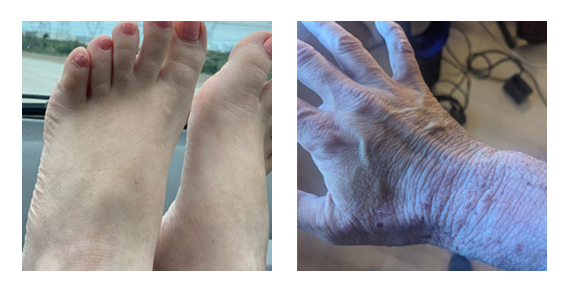
Skin infection
Constant scratching can break the skin barrier, making it more vulnerable to bacterial, viral, or fungal infections. A skin infection can be swollen and sore, feel warm to the touch, and may produce yellow or white pus.4
- What skin infections look like on fair skin – Skin infections can appear as areas of redness and swelling. If the infection is advanced, it may produce pus that looks yellow or white and has a bad odor.4
- What skin infections look like on darker skin – Skin infections may appear lighter or darker than surrounding normal skin. Depending on the skin tone, a skin infection could appear red and inflamed, but it is usually less pronounced than fair skin. White or yellow pus may be present. However, it may be more difficult to see skin infections on darker skin, which may lead to delayed diagnosis or treatment.4
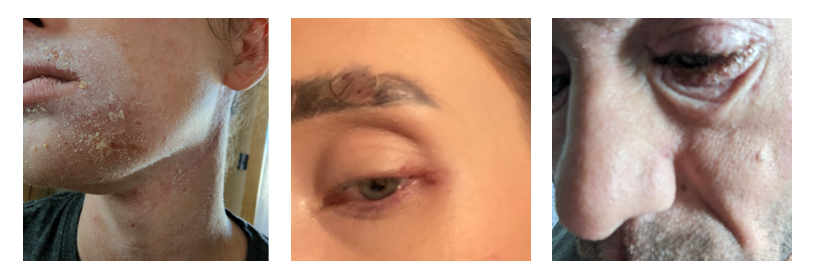
Meet with a dermatologist
If you have any of the above symptoms or are not sure if what you have is eczema or another skin condition, make an appointment to see a dermatologist. They can evaluate your symptoms and determine the best treatment plan for you.